Application of Random Forest Model Integrated with Feature Reduction for Biomass Torrefaction
Abstract
:1. Introduction
2. Materials and Methods
2.1. Data Collection and Pre-Processing
2.2. RF Model Description
2.3. Performance Evaluation Criteria
2.4. Feature Importance Analysis
3. Results and Discussion
3.1. Dataset Description
3.2. Feature Importance
3.3. Prediction Performance of the Feature-Reduced Model
3.4. Partial Dependency
4. Conclusions
Supplementary Materials
Author Contributions
Funding
Institutional Review Board Statement
Informed Consent Statement
Data Availability Statement
Conflicts of Interest
References
- Aniza, R.; Chen, W.; Yang, F.; Pugazhendh, A.; Singh, Y. Integrating Taguchi method and artificial neural network for predicting and maximizing biofuel production via torrefaction and pyrolysis. Bioresour. Technol. 2022, 343, 126140. [Google Scholar] [CrossRef] [PubMed]
- Chen, W.; Lin, B.; Lin, Y.; Chu, Y.; Ubando, A.T.; Show, P.L.; Ong, H.C.; Chang, J.; Ho, S.; Culaba, A.B.; et al. Progress in biomass torrefaction: Principles, applications and challenges. Prog. Energ. Combust. 2021, 82, 100887. [Google Scholar] [CrossRef]
- Seo, M.W.; Lee, S.H.; Nam, H.; Lee, D.; Tokmurzin, D.; Wang, S.; Park, Y. Recent advances of thermochemical conversion processes for biorefinery. Bioresour. Technol. 2022, 343, 126109. [Google Scholar] [CrossRef] [PubMed]
- Liu, Y.; Rokni, E.; Yang, R.; Ren, X.; Sun, R.; Levendis, Y.A. Torrefaction of corn straw in oxygen and carbon dioxide containing gases: Mass/energy yields and evolution of gaseous species. Fuel 2021, 285, 119044. [Google Scholar] [CrossRef]
- González-Arias, J.; Gómez, X.; González-Castaño, M.; Sánchez, M.E.; Rosas, J.G.; Cara-Jiménez, J. Insights into the product quality and energy requirements for solid biofuel production: A comparison of hydrothermal carbonization, pyrolysis and torrefaction of olive tree pruning. Energy 2022, 238, 122022. [Google Scholar] [CrossRef]
- Lokmit, C.; Nakason, K.; Kuboon, S.; Jiratanachotikul, A.; Panyapinyopol, B. Enhancing lignocellulosic energetic properties through torrefaction and hydrothermal carbonization processes. Biomass Convers. Biorefin. 2022. [Google Scholar] [CrossRef]
- Lin, Y.; Chen, W.; Colin, B.; Pétrissans, A.; Lopes Quirino, R.; Pétrissans, M. Thermodegradation characterization of hardwoods and softwoods in torrefaction and transition zone between torrefaction and pyrolysis. Fuel 2022, 310, 122281. [Google Scholar] [CrossRef]
- Kartal, F.; Özveren, U. Prediction of torrefied biomass properties from raw biomass. Renew. Energy 2022, 182, 578–591. [Google Scholar] [CrossRef]
- Samadi, S.H.; Ghobadian, B.; Nosrati, M. Prediction of higher heating value of biomass materials based on proximate analysis using gradient boosted regression trees method. Energy Sources Part A Recovery Util. Environ. Eff. 2021, 43, 672–681. [Google Scholar] [CrossRef]
- Onsree, T.; Tippayawong, N.; Phithakkitnukoon, S.; Lauterbach, J. Interpretable machine-learning model with a collaborative game approach to predict yields and higher heating value of torrefied biomass. Energy 2022, 249, 123676. [Google Scholar] [CrossRef]
- García Nieto, P.J.; García-Gonzalo, E.; Paredes-Sánchez, J.P.; Bernardo Sánchez, A.; Menéndez Fernández, M. Predictive modelling of the higher heating value in biomass torrefaction for the energy treatment process using machine-learning techniques. Neural Comput. Appl. 2019, 31, 8823–8836. [Google Scholar] [CrossRef]
- García Nieto, P.J.; García Gonzalo, E.; Sánchez Lasheras, F.; Paredes Sánchez, J.P.; Riesgo Fernández, P. Forecast of the higher heating value in biomass torrefaction by means of machine learning techniques. J. Comput. Appl. Math. 2019, 357, 284–301. [Google Scholar] [CrossRef]
- Onsree, T.; Tippayawong, N. Machine learning application to predict yields of solid products from biomass torrefaction. Renew. Energy 2021, 167, 425–432. [Google Scholar] [CrossRef]
- Ismail, H.Y.; Fayyad, S.; Ahmad, M.N.; Leahy, J.J.; Naushad, M.; Walker, G.M.; Albadarin, A.B.; Kwapinski, W. Modelling of yields in torrefaction of olive stones using artificial intelligence coupled with kriging interpolation. J. Clean. Prod. 2021, 326, 129020. [Google Scholar] [CrossRef]
- Leng, E.; He, B.; Chen, J.; Liao, G.; Ma, Y.; Zhang, F.; Liu, S.; Jiaqiang, E. Prediction of three-phase product distribution and bio-oil heating value of biomass fast pyrolysis based on machine learning. Energy 2021, 236, 121401. [Google Scholar] [CrossRef]
- Yu, S.; Kim, H.; Park, J.; Lee, Y.; Park, Y.K.; Ryu, C. Relationship between torrefaction severity, product properties, and pyrolysis characteristics of various biomass. Int. J. Energy Res. 2022, 46, 8145–8157. [Google Scholar] [CrossRef]
- Kartal, F.; Özveren, U. Investigation of the chemical exergy of torrefied biomass from raw biomass by means of machine learning. Biomass Bioenergy 2022, 159, 106383. [Google Scholar] [CrossRef]
- BREIMAN, L. Random Forests. Mach. Learn. 2001, 45, 5–32. [Google Scholar] [CrossRef] [Green Version]
- Tang, Q.; Chen, Y.; Yang, H.; Liu, M.; Xiao, H.; Wang, S.; Chen, H.; Raza Naqvi, S. Machine learning prediction of pyrolytic gas yield and compositions with feature reduction methods: Effects of pyrolysis conditions and biomass characteristics. Bioresour. Technol. 2021, 339, 125581. [Google Scholar] [CrossRef]
- Xiaorui, L.; Longji, Y.; Xudong, Y. Evolution of chemical functional groups during torrefaction of rice straw. Bioresour. Technol. 2021, 320, 124328. [Google Scholar] [CrossRef]
- Li, J.; Zhu, X.; Li, Y.; Tong, Y.W.; Ok, Y.S.; Wang, X. Multi-task prediction and optimization of hydrochar properties from high-moisture municipal solid waste: Application of machine learning on waste-to-resource. J. Clean. Prod. 2021, 278, 123928. [Google Scholar] [CrossRef]
- Tang, Q.; Chen, Y.; Yang, H.; Liu, M.; Xiao, H.; Wu, Z.; Chen, H.; Naqvi, S.R. Prediction of Bio-oil Yield and Hydrogen Contents Based on Machine Learning Method: Effect of Biomass Compositions and Pyrolysis Conditions. Energy Fuels 2020, 34, 11050–11060. [Google Scholar] [CrossRef]
- Rasam, S.; Talebkeikhah, F.; Talebkeikhah, M.; Salimi, A.; Moraveji, M.K. Physico-chemical properties prediction of hydrochar in macroalgae Sargassum horneri hydrothermal carbonisation. Int. J. Environ. Chem. 2019, 101, 2297–2318. [Google Scholar] [CrossRef]
- Li, J.; Zhang, W.; Liu, T.; Yang, L.; Li, H.; Peng, H.; Jiang, S.; Wang, X.; Leng, L. Machine learning aided bio-oil production with high energy recovery and low nitrogen content from hydrothermal liquefaction of biomass with experiment verification. Chem. Eng. J. 2021, 425, 130649. [Google Scholar] [CrossRef]
- Li, J.; Pan, L.; Suvarna, M.; Tong, Y.W.; Wang, X. Fuel properties of hydrochar and pyrochar: Prediction and exploration with machine learning. Appl. Energy 2020, 269, 115166. [Google Scholar] [CrossRef]
- Guo, H.N.; Wu, S.B.; Tian, Y.J.; Zhang, J.; Liu, H.T. Application of machine learning methods for the prediction of organic solid waste treatment and recycling processes: A review. Bioresour. Technol. 2021, 319, 124114. [Google Scholar] [CrossRef]
- Yuan, X.; Suvarna, M.; Low, S.; Dissanayake, P.D.; Lee, K.B.; Li, J.; Wang, X.; Ok, Y.S. Applied Machine Learning for Prediction of CO2 Adsorption on Biomass Waste-Derived Porous Carbons. Environ. Sci. Technol. 2021, 55, 11925–11936. [Google Scholar] [CrossRef]
- Zhu, X.; Wan, Z.; Tsang, D.C.W.; He, M.; Hou, D.; Su, Z.; Shang, J. Machine learning for the selection of carbon-based materials for tetracycline and sulfamethoxazole adsorption. Chem. Eng. J. 2021, 406, 126782. [Google Scholar] [CrossRef]
- Ullah, Z.; Khan, M.; Raza Naqvi, S.; Farooq, W.; Yang, H.; Wang, S.; Vo, D.N. A comparative study of machine learning methods for bio-oil yield prediction – A genetic algorithm-based features selection. Bioresour. Technol. 2021, 335, 125292. [Google Scholar] [CrossRef]
- Conag, A.T.; Villahermosa, J.E.R.; Cabatingan, L.K.; Go, A.W. Energy densification of sugarcane leaves through torrefaction under minimized oxidative atmosphere. Energy Sustain. Dev. 2018, 42, 160–169. [Google Scholar] [CrossRef]
- Adeleke, A.A.; Odusote, J.K.; Ikubanni, P.P.; Lasode, O.A.; Malathi, M.; Paswan, D. Essential basics on biomass torrefaction, densification and utilization. Int. J. Energy Res. 2021, 45, 1375–1395. [Google Scholar] [CrossRef]
- Guo, S.; Guo, T.; Che, D.; Liu, H.; Sun, B. Response surface analysis of energy balance and optimum condition for torrefaction of corn straw. Korean J. Chem. Eng. 2022, 39, 1287–1298. [Google Scholar] [CrossRef]
- McNamee, P.; Adams, P.W.R.; McManus, M.C.; Dooley, B.; Darvell, L.I.; Williams, A.; Jones, J.M. An assessment of the torrefaction of North American pine and life cycle greenhouse gas emissions. Energy Convers. Manag. 2016, 113, 177–188. [Google Scholar] [CrossRef] [Green Version]
- Kanwal, S.; Chaudhry, N.; Munir, S.; Sana, H. Effect of torrefaction conditions on the physicochemical characterization of agricultural waste (sugarcane bagasse). Waste Manag. 2019, 88, 280–290. [Google Scholar] [CrossRef]

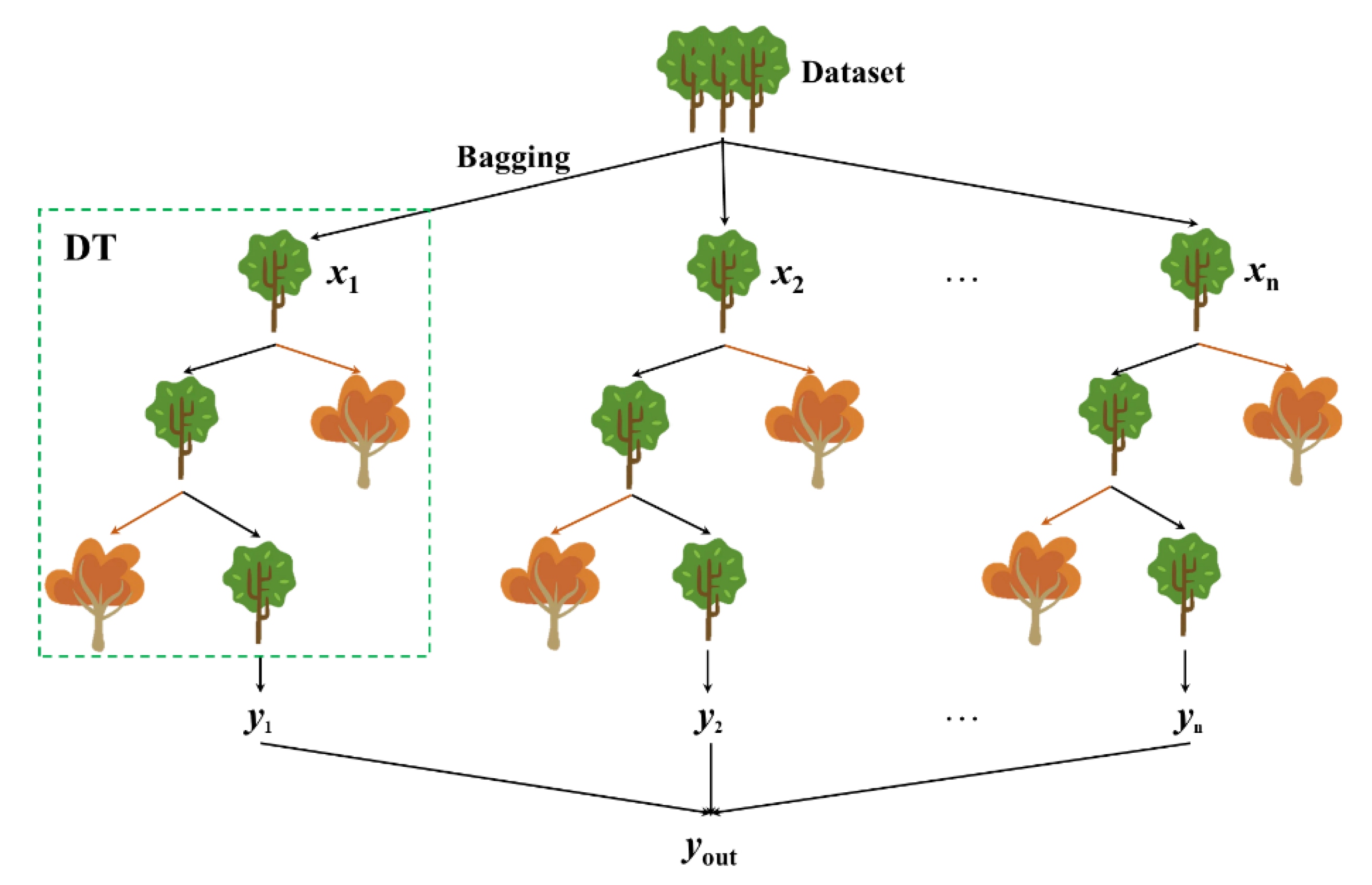
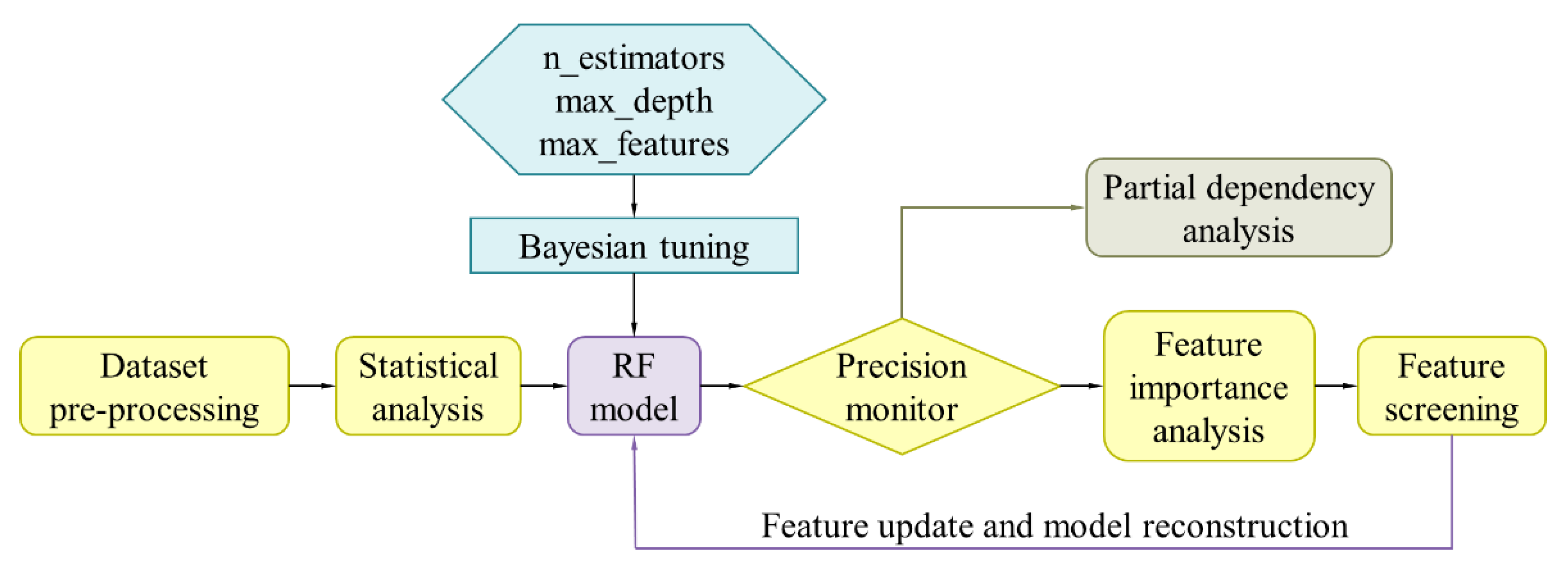
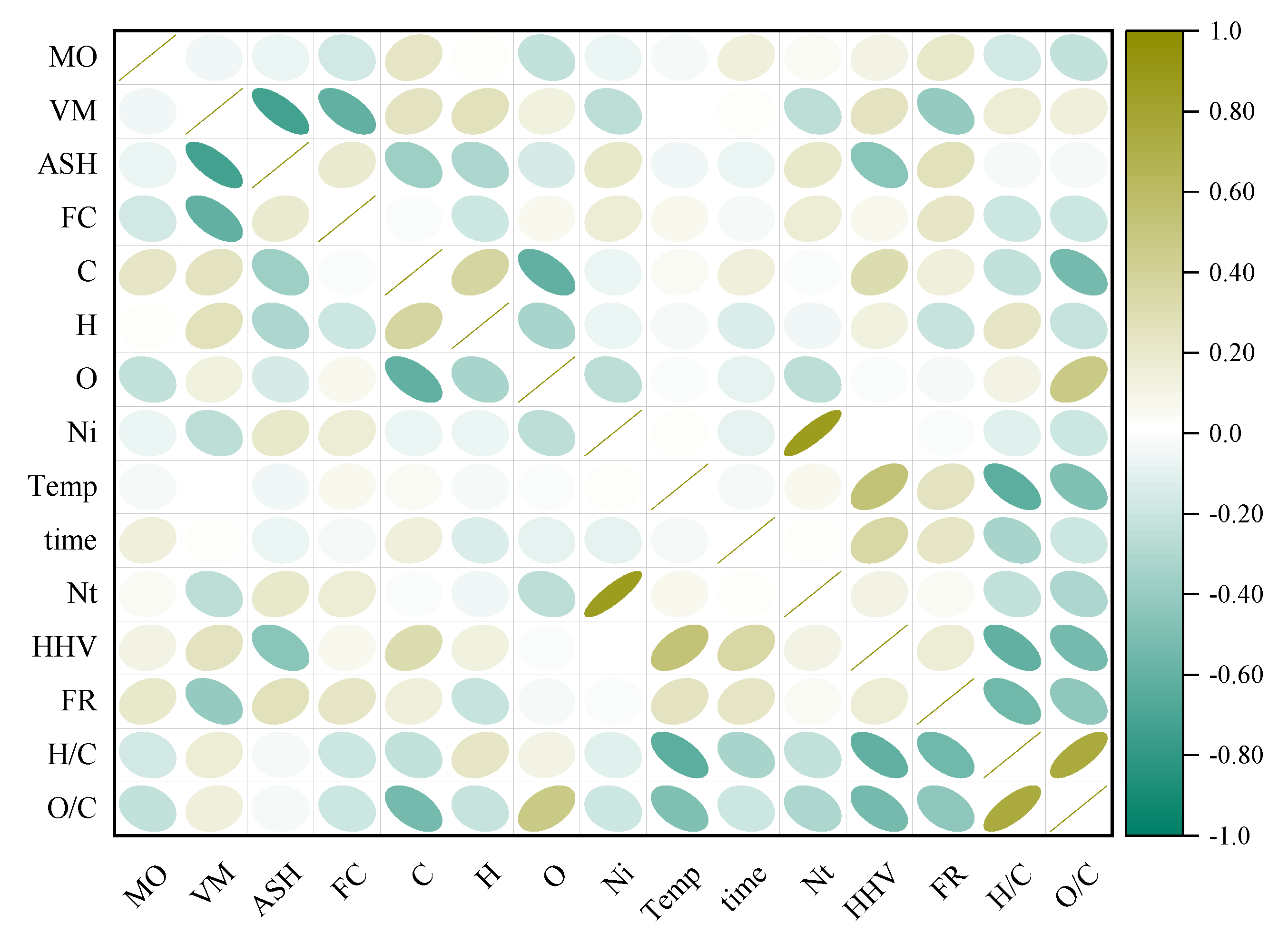
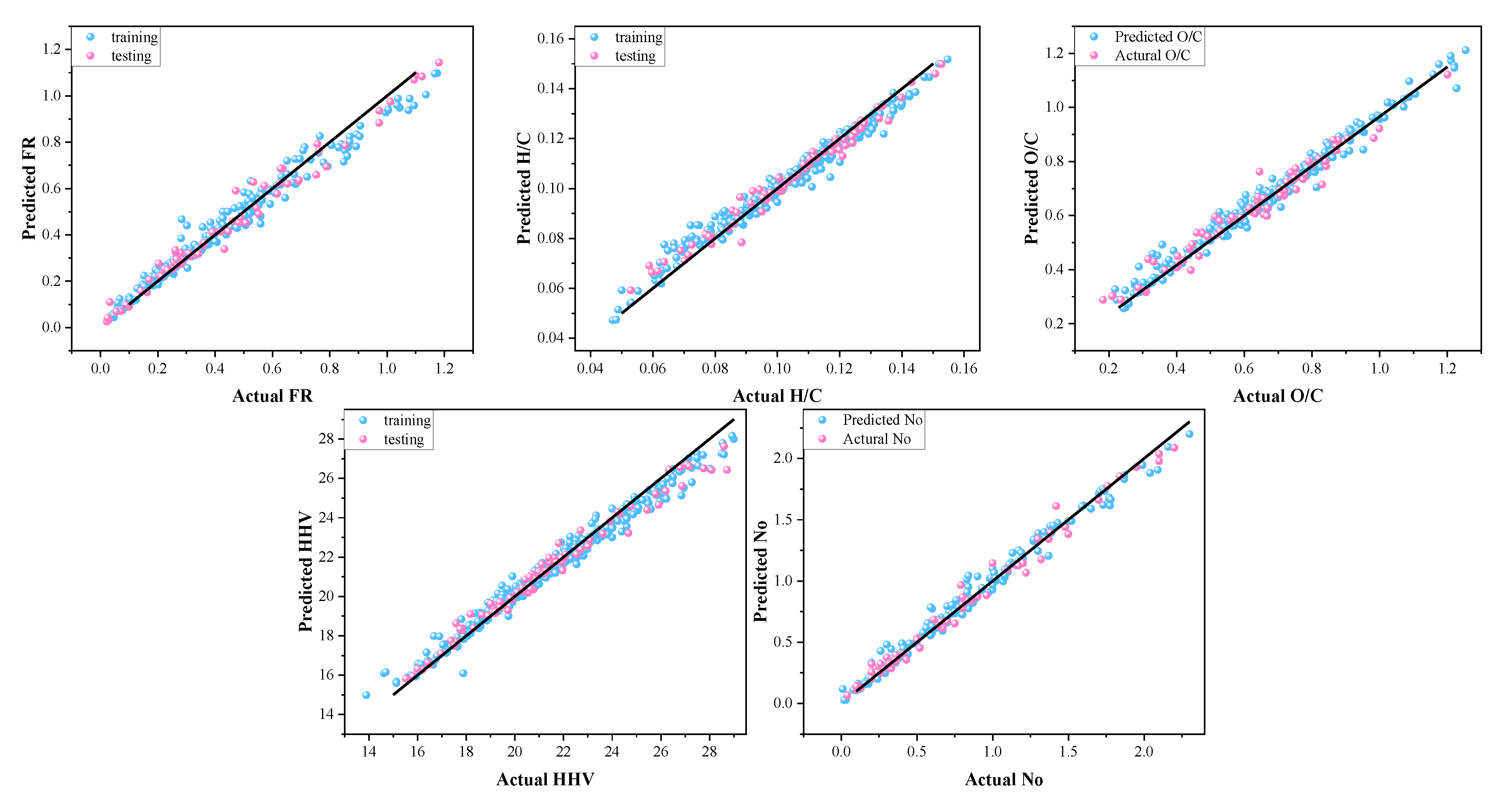
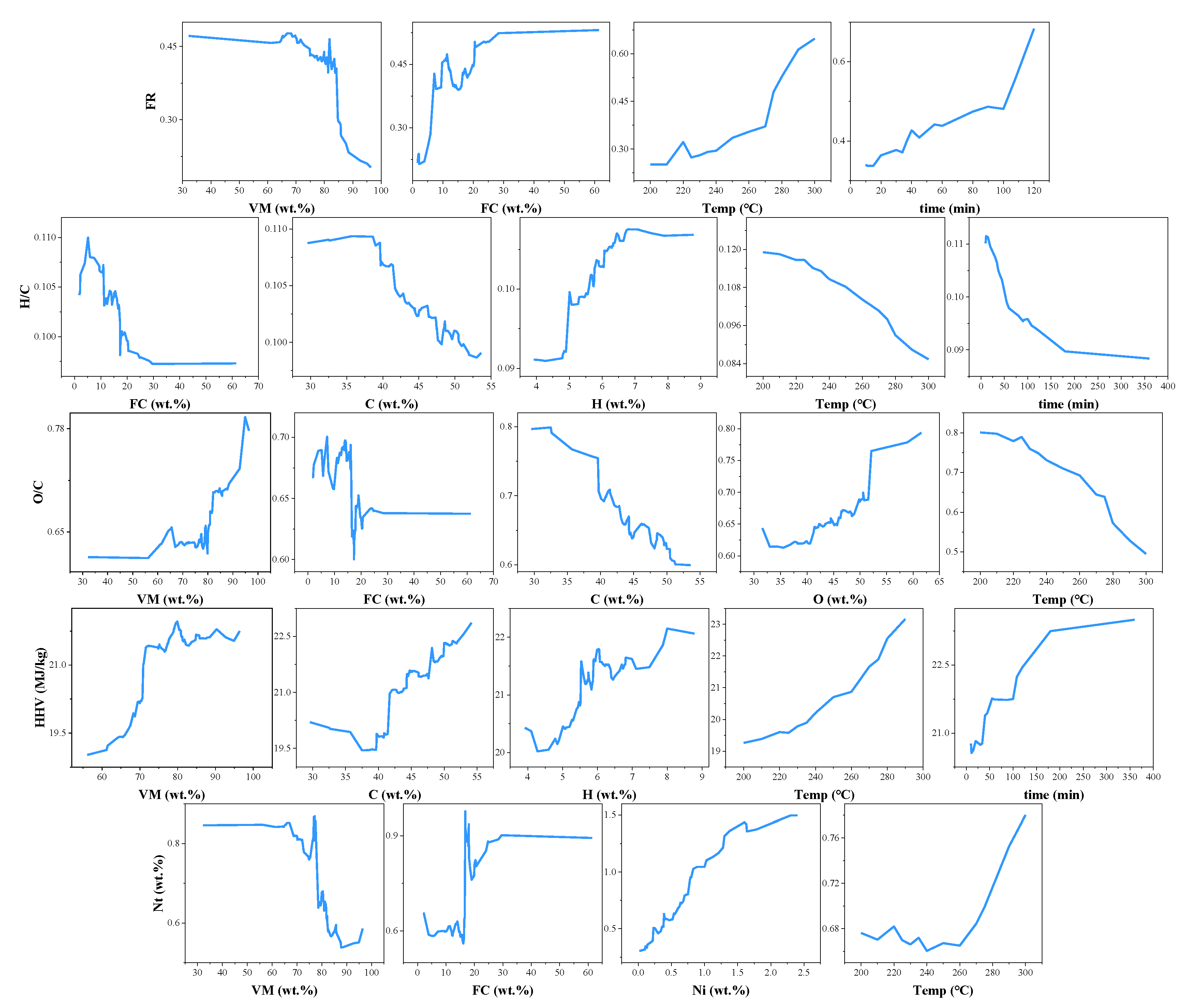
| n_Estimators | max_Depth | max_Features | |
|---|---|---|---|
| FR | 174 | 16 | 0.353 |
| HC | 112 | 29 | 0.313 |
| OC | 174 | 27 | 0.232 |
| HHV | 141 | 46 | 0.353 |
| Nt | 97 | 41 | 0.596 |
| Feature | Name | Unit | Count | Range | Mean | Median | Std |
|---|---|---|---|---|---|---|---|
| Moisture content | MO | wt.% | 515 | 0~14.8 | 4.33 | 4.55 | 4.12 |
| Volatile content | VM | wt.% | 515 | 32.2~96.4 | 77.02 | 78.9 | 8.28 |
| Ash content | ASH | wt.% | 515 | 0~32.58 | 5.48 | 3.3 | 5.76 |
| Fixed carbon content | FC | wt.% | 510 | 1.67~61.4 | 14.72 | 15.47 | 5.91 |
| Carbon content | C | wt.% | 497 | 29.59~54.16 | 44.83 | 45.1 | 4.73 |
| Hydrogen content | H | wt.% | 497 | 3.92~8.78 | 5.99 | 6.03 | 0.69 |
| Oxygen content | O | wt.% | 488 | 11.37~61.55 | 43.83 | 44.46 | 7.57 |
| Nitrogen content input | Ni | wt.% | 488 | 0~14.29 | 1.24 | 0.59 | 2.09 |
| Temperature | Temp | °C | 515 | 200~300 | 255.27 | 250 | 32.63 |
| Duration time | Time | min | 491 | 10~360 | 46.78 | 30 | 35.20 |
| Nitrogen content output | Nt | wt.% | 379 | 0~8.32 | 0.94 | 0.65 | 1.066 |
| High heating value | HHV | MJ/kg | 491 | 13.48~225.5 | 21.45 | 20.67 | 9.76 |
| Fuel ratio | FR | — | 436 | 0.02~7.19 | 0.53 | 0.36 | 0.65 |
| H/C ratio | H/C | — | 397 | 0.03~0.16 | 0.10 | 0.11 | 0.02 |
| O/C ratio | O/C | — | 380 | 0.06~1.87 | 0.70 | 0.68 | 0.29 |
| MO | VM | FC | C | H | O | Ni | Temp | Time | |
|---|---|---|---|---|---|---|---|---|---|
| FR | 0.0467 | 0.1217 | 0.1872 | 0.0417 | 0.0442 | 0.0460 | 0.0487 | 0.4033 | 0.0605 |
| H/C | 0.0486 | 0.0659 | 0.0877 | 0.0886 | 0.0935 | 0.0781 | 0.0549 | 0.3732 | 0.1094 |
| O/C | 0.0690 | 0.0770 | 0.0853 | 0.1045 | 0.0547 | 0.1408 | 0.0876 | 0.3069 | 0.0742 |
| Nt | 0.0473 | 0.0969 | 0.1023 | 0.0632 | 0.0249 | 0.0318 | 0.5438 | 0.0533 | 0.0365 |
| HHV | 0.0321 | 0.1694 | 0.0600 | 0.1579 | 0.078 | 0.0643 | 0.0552 | 0.3113 | 0.0719 |
| Target | Features |
|---|---|
| FR | VM, FC, Temp, time |
| H/C | FC, C, H, Temp, time |
| O/C | VM, FC, C, O, Temp |
| Nt | VM, FC, Ni, Temp |
| HHV | VM, C, H, Temp, time |
| FR | H/C | O/C | HHV | Nt | |
|---|---|---|---|---|---|
| R2 (training) | 0.9649 | 0.9653 | 0.9589 | 0.9774 | 0.982 |
| RMSE (training) | 0.048 | 0.0043 | 0.0448 | 0.4671 | 0.0679 |
| R2 (testing) | 0.9485 | 0.9654 | 0.9315 | 0.9649 | 0.9746 |
| RMSE (testing) | 0.0585 | 0.0042 | 0.0579 | 0.5819 | 0.0808 |
Publisher’s Note: MDPI stays neutral with regard to jurisdictional claims in published maps and institutional affiliations. |
© 2022 by the authors. Licensee MDPI, Basel, Switzerland. This article is an open access article distributed under the terms and conditions of the Creative Commons Attribution (CC BY) license (https://creativecommons.org/licenses/by/4.0/).
Share and Cite
Liu, X.; Yang, H.; Yang, J.; Liu, F. Application of Random Forest Model Integrated with Feature Reduction for Biomass Torrefaction. Sustainability 2022, 14, 16055. https://doi.org/10.3390/su142316055
Liu X, Yang H, Yang J, Liu F. Application of Random Forest Model Integrated with Feature Reduction for Biomass Torrefaction. Sustainability. 2022; 14(23):16055. https://doi.org/10.3390/su142316055
Chicago/Turabian StyleLiu, Xiaorui, Haiping Yang, Jiamin Yang, and Fang Liu. 2022. "Application of Random Forest Model Integrated with Feature Reduction for Biomass Torrefaction" Sustainability 14, no. 23: 16055. https://doi.org/10.3390/su142316055






